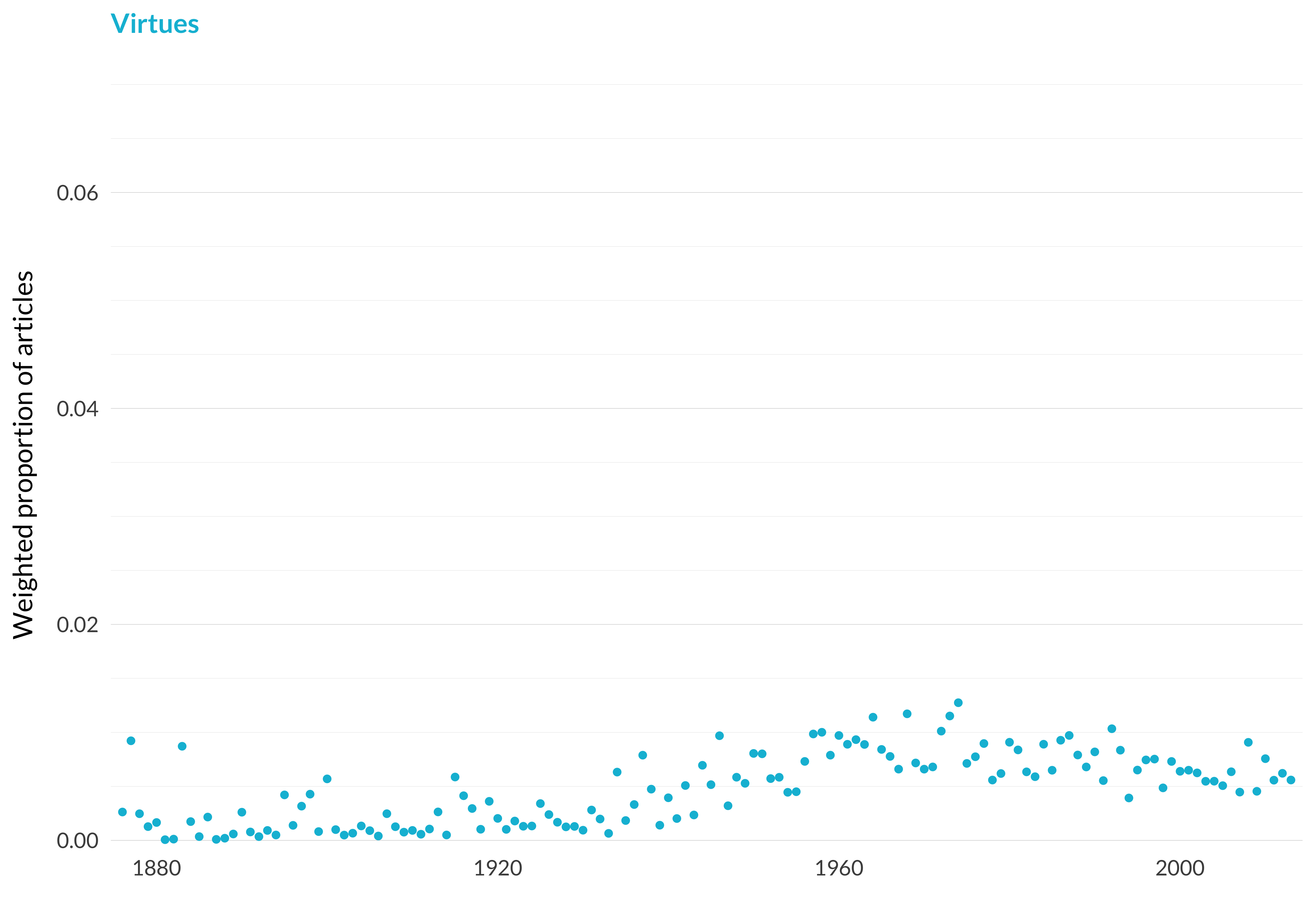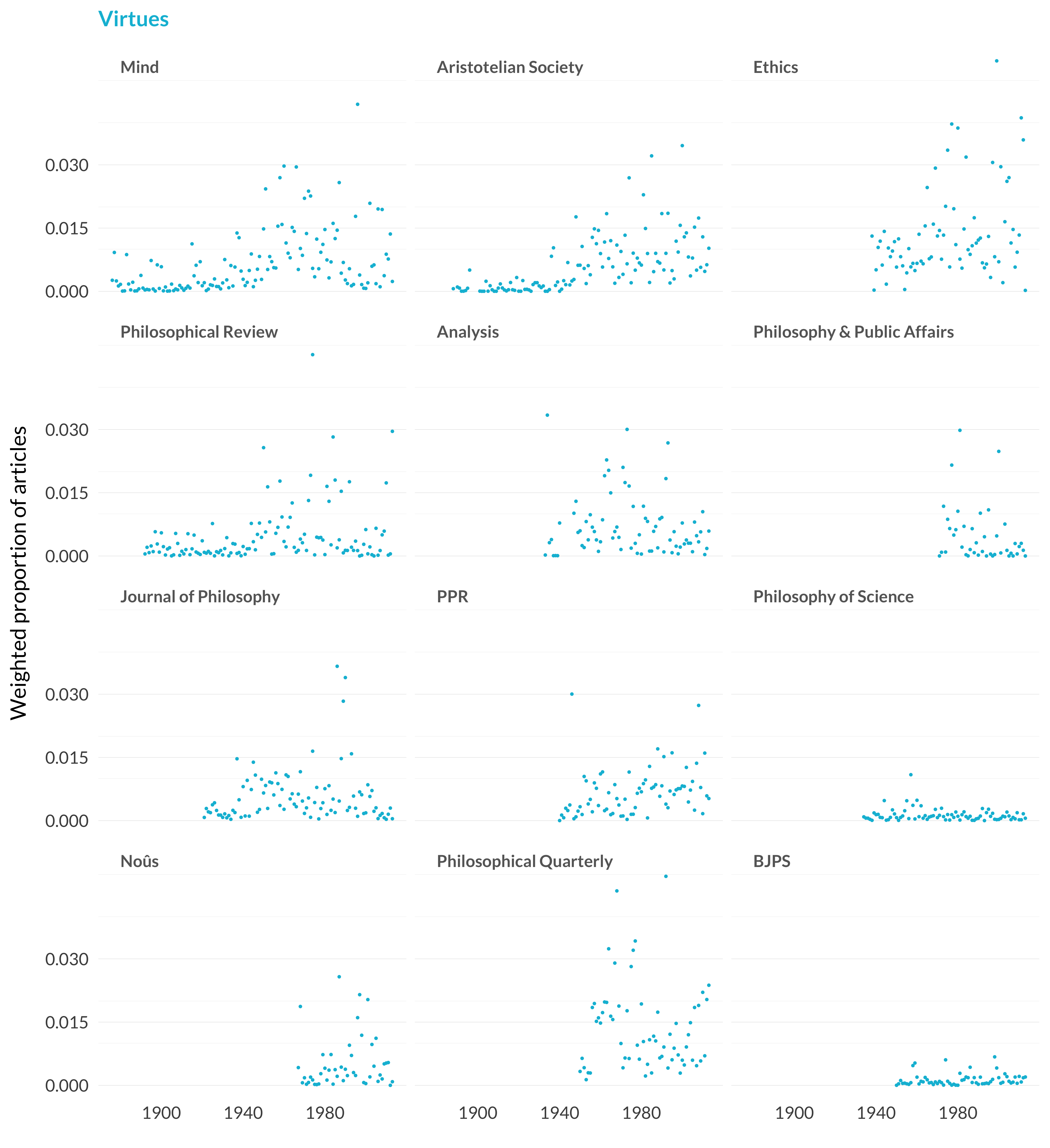2.49 Virtues
Category: Ethics
Keywords: judgements, stevenson, virtuous, judgement, virtues, courage, emotive, judging, evaluative, evaluations, thick, hare, merit, egoism, appraisal
Number of Articles: 199
Percentage of Total: 0.6%
Rank: 75th
Weighted Number of Articles: 209.3
Percentage of Total: 0.7%
Rank: 81st
Mean Publication Year: 1978.2
Weighted Mean Publication Year: 1975.4
Median Publication Year: 1976
Modal Publication Year: 1968
Topic with Most Overlap: Ordinary Language (0.0653)
Topic this Overlaps Most With: Moral Conscience (0.0239)
Topic with Least Overlap: Quantum Physics (0.00033)
Topic this Overlaps Least With: Quantum Physics (0.00022)

Figure 2.117: Virtues.

Figure 2.118: Virtues articles in each journal.
Comments
Given that this topic covers virtue ethics, discussions of individual virtues, and emotivism, I was surprised to see how low it came in. I was particularly surprised to see so little life in the Journal of Philosophy graph and not even much in the Philosophy and Public Affairs graph. The split between ethics and political philosophy is very visible here
A slight surprise is that “Stevenson” turns up as a keyword. It isn’t surprising that this is a keyword at all; Charles Leslie Stevenson is one of the most important figures in midcentury philosophy. It’s rather that it isn’t entirely clear why the model put the work that engages with Stevenson here rather than somewhere else.
Part of what makes this odd is that the model only puts one of Stevenson’s own journal articles in this topic.
| Year | Article | Subject | Probability |
|---|---|---|---|
| 1937 | Charles Leslie Stevenson, 1937, “The Emotive Meaning of Ethical Terms,” Mind 46:14–31. | Ordinary Language | 0.2141 |
| 1938 | Charles Leslie Stevenson, 1938, “Persuasive Definitions,” Mind 47:331–50. | Virtues | 0.2357 |
| 1938 | Charles Leslie Stevenson, 1938, “Ethical Judgments and Avoidability,” Mind 47:45–57. | Promises and Imperatives | 0.1962 |
| 1947 | Charles L. Stevenson, 1947, “Some Relations Between Philosophy and the Study of Language,” Analysis 8:1–9. | Ordinary Language | 0.3154 |
| 1948 | Charles L. Stevenson, 1948, “Meaning: Descriptive and Emotive,” Philosophical Review 57:127–44. | Definitions | 0.2303 |
| 1950 | Charles L. Stevenson, 1950, “The Emotive Conception of Ethics and Its Cognitive Implications,” Philosophical Review 59:291–304. | Ordinary Language | 0.1996 |
| 1950 | Charles L. Stevenson, 1950, “Brandt’s Questions About Emotive Ethics,” Philosophical Review 59:528–34. | Definitions | 0.2335 |
| 1957 | Charles L. Stevenson, 1957, “On”What is a Poem?",” Philosophical Review 66:329–62. | Ordinary Language | 0.2705 |
| 1958 | Charles L. Stevenson, 1958, “On the”Analysis" of a Work of Art,” Philosophical Review 67:33–51. | Beauty | 0.3080 |
| 1962 | Charles L. Stevenson, 1962, “Reflections on John Dewey’s Ethics,” Proceedings of the Aristotelian Society 62:77–98. | Ordinary Language | 0.2808 |
| 1970 | Charles L. Stevenson, 1970, “If-Iculties,” Philosophy of Science 37:27–49. | Propositions and Implications | 0.3320 |
Stevenson’s own most important work, the book Ethics and Language, is not part of this study. But we can look at the works that engage with that book. But it’s good to look directly at the raw data. Which articles use the word Stevenson most often? And do those articles mean to refer to Charles Leslie Stevenson?
| Article | Subject | Word Count |
|---|---|---|
| Kurt Baier, 1967, “Fact, Value, and Norm in Stevenson’s Ethics,” Noûs 1:139–60. | Norms | 88 |
| Stuart Gerry Brown, 1959, “Eisenhower and Stevenson in the McCarthy Era: A Study in Leadership,” Ethics 69:233–54. | War | 81 |
| Stuart Gerry Brown, 1960, “Civil Rights and National Leadership: Eisenhower and Stevenson in the 1950’s,” Ethics 70:118–34. | War | 54 |
| Leslie Stevenson and Ralph Walker, 1983, “Empirical Realism and Transcendental Anti-Realism,” Proceedings of the Aristotelian Society (Supplementary Volume) 57:131–77. | Ordinary Language | 47 |
| W. H. Hay, 1947, “C. L. Stevenson and Ethical Analysis,” Philosophical Review 56:422–30. | Definitions | 45 |
| Mike Ridge, 2013, “Disagreement,” Philosophy and Phenomenological Research 86:41–63. | Norms | 45 |
| Vincent Tomas, 1951, “Ethical Disagreements and the Emotive Theory of Values,” Mind 60:205–22. | Virtues | 44 |
| Richard Robinson, H. J. Paton and R. C. Cross, 1948, “Symposium: The Emotive Theory of Ethics,” Proceedings of the Aristotelian Society (Supplementary Volume) 22:79–140. | Ordinary Language | 41 |
| Alexander Sesonske, 1953, “On the Skepticism of Ethics and Language,” Journal of Philosophy 50:608–16. | Norms | 40 |
| Asher Moore, 1951, “The Emotive Theory and Rational Methods in Moral Controversy,” Mind 60:233–40. | Moral Conscience | 39 |
The two articles by Brown are about Adlai Stevenson, and the exchange between Leslie Stevenson and Ralph Walker is about Leslie Stevenson, but the rest I believe are about Charles Leslie Stevenson. And they naturally spread across a range of topics.
I think that part of what’s happening here is that Stevenson’s work is so wide-ranging that the model doesn’t feel comfortable putting it into any one topic. Look, for instance, at how low the numbers are in the table of Stevenson’s work. It somehow left the word stevenson in this model, but that’s balanced out by the fact that the words Stevenson himself used are mostly in other topics.